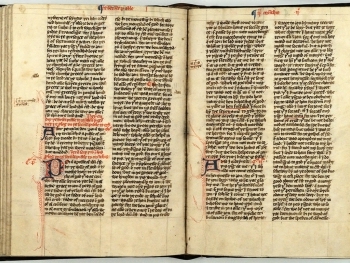The Revised Geneva Translation (RGT) is a modern adaptation of the Geneva Bible, a significant Protestant translation first published in the 16th century. The Geneva Bible, known for its extensive marginal notes and influence on early English Protestantism, served as a key text for the Reformation and was widely used by the Puritans. The Revised Geneva Translation seeks to update and preserve the essence of the original Geneva Bible while making it accessible to contemporary readers. This post explores the specific aspects of the RGT, compares it to the King James Version (KJV), examines its impact on Bible memorization, and discusses its theological distinctives.
Specific Aspects of the RGT
1. Translation Philosophy: The RGT adheres to a formal equivalence approach, similar to its predecessor, the Geneva Bible. This approach focuses on translating the original Hebrew, Aramaic, and Greek texts as directly as possible while retaining readability. The RGT aims to be both faithful to the source texts and accessible to modern readers.
2. Textual Basis: The RGT is based on the Textus Receptus for the New Testament and the Masoretic Text for the Old Testament, aligning with the textual basis of the Geneva Bible. This adherence ensures continuity with the historical foundations of the translation while incorporating contemporary scholarly insights.
3. Marginal Notes: One of the defining features of the Geneva Bible was its extensive marginal notes, which provided commentary, theological insights, and explanations. The RGT maintains a selection of these notes, updated to reflect modern scholarship and contemporary theological perspectives, offering readers additional context and interpretation.
4. Language and Style: The RGT updates the language of the Geneva Bible to reflect contemporary usage while preserving its traditional style. This balance aims to make the text understandable to modern readers without losing the historical and theological flavor of the original.
5. Preservation of Reformation Heritage: The RGT retains the Reformation-era perspectives embedded in the Geneva Bible, including its emphasis on personal interpretation of Scripture and the centrality of Protestant doctrines. This preservation reflects the historical significance of the Geneva Bible in shaping Protestant theology.
6. Modern Scholarly Updates: The RGT incorporates updates from modern biblical scholarship, including advances in textual criticism and historical research. These updates aim to enhance accuracy and provide a translation that reflects current scholarly understanding.
Comparison to the King James Version (KJV)
1. Translation Philosophy:
- RSV Philosophy: Both the RGT and KJV follow a formal equivalence approach, but the KJV was first published in 1611 and reflects the textual and linguistic understanding of the early 17th century. The RGT, however, benefits from more recent scholarship and aims to modernize the language while staying true to the Geneva Bible’s principles.
- KJV Philosophy: The KJV also emphasizes formal equivalence, with a focus on maintaining the poetic and majestic style that has been influential in English-speaking Christianity. Its translation was based on the Textus Receptus and the Masoretic Text, similar to the RGT.
2. Language and Style:
- RSV Language: The RGT updates the Geneva Bible’s language to make it more accessible to modern readers. It incorporates contemporary linguistic usage while aiming to preserve the historical and theological context.
- KJV Language: The KJV is known for its early modern English, characterized by its formal and poetic style. While revered for its literary qualities, the KJV’s archaic language can be challenging for contemporary readers.
3. Marginal Notes and Commentary:
- RSV Notes: The RGT includes updated marginal notes reflecting modern scholarship and theological insights, which were a prominent feature of the original Geneva Bible.
- KJV Notes: The KJV does not have the extensive marginal notes found in the Geneva Bible or the RGT. Its translation focus is on the text itself rather than supplementary commentary.
4. Historical Influence:
- RSV Influence: The RGT maintains the historical influence of the Geneva Bible within a modern context, reflecting the Reformation’s theological perspectives.
- KJV Influence: The KJV has had a profound influence on English-speaking Christianity, shaping both religious practice and literary expression. Its impact extends beyond theology into cultural and literary realms.
Comparison Summary: The RGT updates the Geneva Bible’s language and incorporates modern scholarship, making it accessible to contemporary readers while preserving Reformation-era insights. The KJV, with its formal and poetic style, represents an earlier stage of English translation and has a significant historical and literary impact. The RGT provides a bridge between the historical Geneva Bible and modern readers, while the KJV continues to be valued for its traditional and majestic language.
Impact on Bible Memorization
1. Modern Readability: The RGT’s updated language enhances readability, which can aid in Bible memorization. By using contemporary terms and sentence structures, the RGT makes memorization easier for modern readers compared to the archaic language of older translations like the KJV.
2. Consistency with Historical Texts: For readers familiar with the Geneva Bible, the RGT offers a sense of continuity with traditional texts. This consistency can facilitate memorization for those who have studied the Geneva Bible and wish to maintain familiarity with its phrasing and style.
3. Retention of Key Phrases: The RGT retains many of the key phrases and theological concepts from the Geneva Bible, helping readers remember significant passages and doctrines. The preservation of traditional expressions alongside modern updates supports effective memorization.
4. Enhanced Understanding: The RGT’s marginal notes and updated commentary provide additional context and explanation, which can enhance understanding and retention of biblical texts. This contextual support aids in memorization by helping readers grasp the meaning behind the verses.
5. Educational Use: The RGT’s modernized language and scholarly updates make it a useful tool for educational settings, including Sunday schools and Bible study groups. Its readability and explanatory notes support effective memorization and teaching.
Theological Distinctives
1. Reformation Heritage: The RGT reflects the theological perspectives of the Reformation, emphasizing doctrines such as sola scriptura (Scripture alone) and the priesthood of all believers. These theological distinctives are rooted in the original Geneva Bible and continue to influence the RGT.
2. Preservation of Marginal Notes: The inclusion of updated marginal notes allows the RGT to maintain the interpretative and doctrinal insights of the Geneva Bible. These notes provide readers with theological context and reflections aligned with Protestant beliefs.
3. Formal Equivalence Approach: The RGT’s commitment to formal equivalence ensures that it remains true to the original texts while updating language for modern readers. This approach supports theological accuracy and continuity with the Reformation-era translation principles.
4. Modern Scholarship Integration: The RGT incorporates insights from modern biblical scholarship, including advances in textual criticism and historical research. This integration enhances the translation’s accuracy and reflects contemporary theological understanding.
5. Continuity with Historical Texts:
By retaining elements of the Geneva Bible’s language and commentary, the RGT maintains a connection with historical Protestant texts. This continuity supports a consistent theological perspective and preserves the historical impact of the original Geneva Bible.
The Revised Geneva Translation (RGT) represents a significant update to the Geneva Bible, bridging historical Protestant translation with contemporary readability. Its formal equivalence approach, modernized language, and retention of Reformation-era insights provide a valuable resource for modern readers and scholars.
When compared to the King James Version, the RGT offers a more accessible language while preserving traditional theological perspectives and commentary. Its impact on Bible memorization is enhanced by its readability and explanatory notes, making it a useful tool for personal and educational purposes.
Theological distinctives of the RGT include its adherence to Reformation principles, preservation of marginal notes, and integration of modern scholarship. As a translation that respects historical texts while addressing contemporary needs, the RGT continues to be a meaningful resource for those seeking a modern yet historically grounded understanding of the Scriptures.
Modern Bible translations Revised Geneva Translation RGT Bible translation King James Version comparison Bible memorization Geneva Bible updates Theological insights RGT Reformation-era translations Bible translation features Historical Protestant texts






